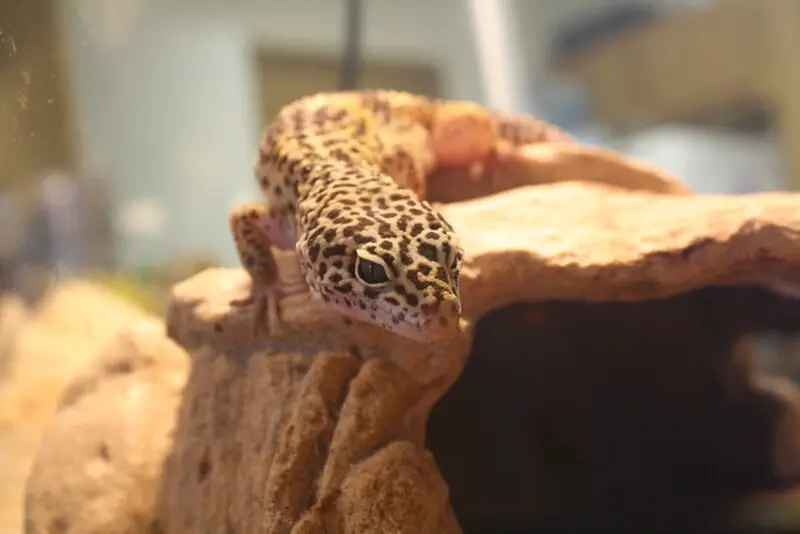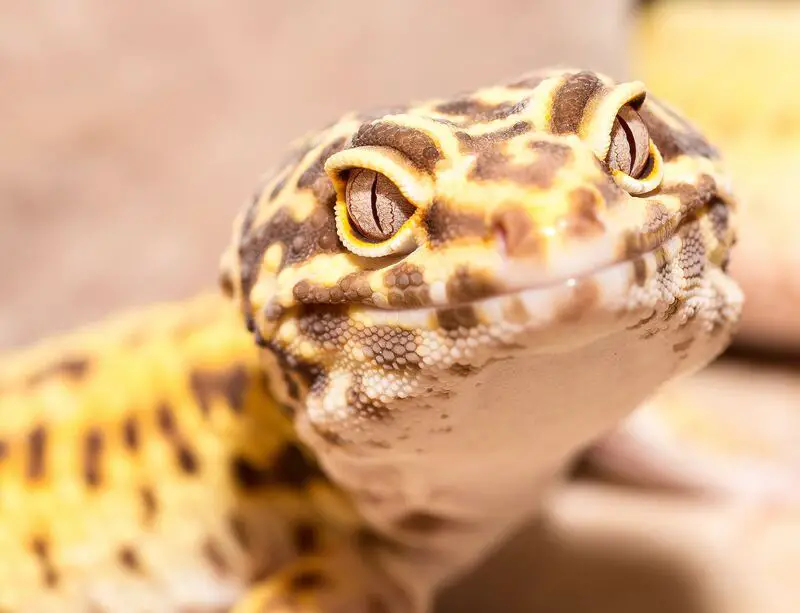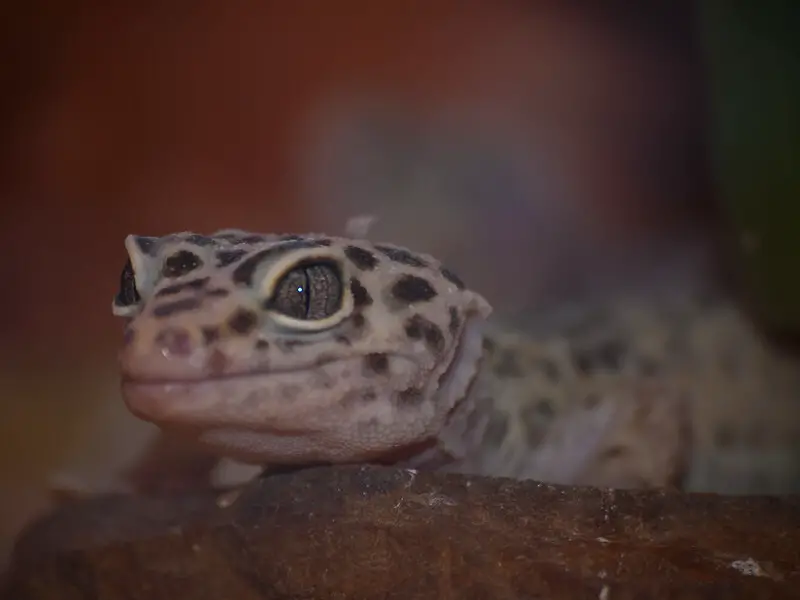Leopard geckos are known for their striking and vibrant coloration, and their unique patterns can make them a popular choice among reptile enthusiasts and pet owners. However, if you’ve noticed that your leopard gecko looks pale, it can be a cause for concern. A pale appearance in leopard geckos may indicate underlying health issues, shedding, or even natural color changes. In this comprehensive guide, we will explore the various reasons why your leopard gecko might look pale and what you can do to address the issue.

Normal Color Variation in Leopard Geckos
Leopard geckos exhibit a wide range of color patterns, and their coloration can vary depending on their age, genetics, and even environmental conditions. It’s important to note that leopard geckos can naturally have variations in their coloration that do not necessarily indicate any health concerns.
- Hatchling and Juvenile Coloration: Young leopard geckos may have brighter and more vibrant colors compared to adults. As they mature, their coloration can change and become more subdued.
- Genetics: Different leopard gecko morphs have unique color patterns and pigmentation. For example, there are albino morphs that lack dark pigmentation and appear paler compared to wild-type geckos.
- Temperature and Lighting: The environmental conditions in their enclosure can also influence their coloration. Cooler temperatures may lead to paler colors, while warmer temperatures can intensify their pigmentation.
- Stress and Mood: Leopard geckos can change color slightly based on their mood and stress levels. They may darken or lighten their coloration as a response to various stimuli.
Given these natural variations in coloration, it’s important to distinguish between normal color changes and a leopard gecko looking pale due to health or shedding issues.
Health-Related Reasons for a Pale Leopard Gecko
A pale or ashen appearance in a leopard gecko can be a sign of an underlying health problem. Several health-related issues can cause a leopard gecko to look pale, and they may require prompt attention. Here are some of the common health-related reasons for a pale leopard gecko:
1. Stress
Stress is a common cause of color change in leopard geckos. When stressed, leopard geckos may pale in color as a response to the perceived threat or discomfort. Various factors can cause stress in leopard geckos, including:
- Handling: Excessive or rough handling can stress out leopard geckos. They may lighten their color as a sign of stress.
- Environmental Changes: Changes in their enclosure, such as new decorations, substrates, or cage mates, can stress them temporarily.
- Overcrowding: Keeping multiple geckos in a small enclosure without enough hiding spots can lead to stress.
- Inadequate Hiding Spots: Insufficient hiding spots in their enclosure can make leopard geckos feel exposed and vulnerable.
To address stress-related paleness, ensure that your gecko’s enclosure is appropriately set up with hiding spots, reduce handling or interactions when necessary, and make changes to their environment gradually.
2. Illness
A pale appearance can be a sign that your leopard gecko is unwell. Illnesses or infections can cause various physiological changes, including alterations in pigmentation. Common health issues that may cause paleness include:
- Infections: Bacterial or fungal infections can affect a gecko’s overall health and lead to changes in skin color.
- Metabolic Bone Disease (MBD): MBD can weaken their bones and negatively impact their overall health, potentially leading to paleness.
- Parasites: Internal parasites, such as flagellated protozoa or nematodes, can cause paleness and other symptoms.
- Respiratory Infections: Respiratory infections can stress geckos and may result in paleness.
- Other Ailments: Liver problems, kidney disease, and other internal health issues can manifest as paleness.
If you suspect that your leopard gecko is unwell, it is crucial to consult a veterinarian with experience in reptile care. Prompt diagnosis and treatment are essential for a better prognosis.
3. Shedding
Leopard geckos undergo periodic shedding of their skin, which is a natural and essential process. When a gecko is about to shed, it will often appear paler as the new skin develops beneath the old one. Shedding-related paleness is typically temporary and should resolve once the shed is complete.
Signs that your leopard gecko is preparing to shed include:
- A cloudy or dull appearance in the eyes (opaque eye caps).
- A paler or lighter skin coloration.
- Increased time spent hiding or reduced activity.
- Reduced appetite.
- Scratching or rubbing against surfaces in the enclosure.
To facilitate a successful shed, maintain the appropriate humidity level in their enclosure by providing a humidity box or moist hide. This helps soften the old skin, making it easier for the gecko to shed. Once the shed is complete, your gecko’s color should return to normal.

Shedding Problems
While shedding is a natural process for leopard geckos, it can sometimes become problematic. Shedding difficulties can result in retained skin, which may appear as patches of stuck shed on the gecko’s body. This retained shed can restrict blood flow, lead to infection, or cause other complications.
Common causes of shedding problems include:
- Low Humidity: Inadequate humidity levels in the enclosure can make it challenging for the gecko to shed its skin properly. Insufficient humidity can lead to pieces of the old skin becoming stuck.
- Dehydration: Dehydrated geckos may have difficulty shedding, as their skin may not loosen as easily.
- Injury: Any injuries or abrasions to the skin can make shedding more challenging, as the old skin may not detach properly from the injured area.
To help prevent shedding problems, maintain appropriate humidity levels, offer a humidity box or moist hide, and ensure your gecko has access to clean water. If you notice signs of retained shed, you can gently assist your gecko in removing the stuck skin by providing a warm and shallow bath.
To create a shedding bath for your leopard gecko:
- Use a small container or plastic tub filled with lukewarm water. Ensure the water level is shallow enough to prevent drowning but deep enough to cover the gecko’s legs.
- Gently place your gecko in the water and allow it to soak for about 10-15 minutes. You can supervise and gently rub any areas with retained shed using your fingers.
- After the bath, use a soft, damp cloth to gently wipe off any loosened pieces of skin.
- Avoid forcibly pulling or tearing off any stuck shed, as this can harm the gecko.
Repeat the shedding bath as needed until all the retained shed has been removed.
Addressing Pale Skin in Leopard Geckos
If your leopard gecko’s pale appearance is not due to shedding, stress, or temporary factors, and if it persists for an extended period, it’s essential to take appropriate steps to address the issue. Here are the steps you can take to help a pale leopard gecko:
- Check Environmental Conditions: Ensure that the temperature, lighting, and humidity levels in the enclosure are appropriate. Leopard geckos require a warm basking spot and access to a humid hide during shedding.
- Evaluate Diet and Nutrition: Review your gecko’s diet to ensure it is varied and nutritionally balanced. A diet that lacks essential nutrients can affect their overall health and appearance.
- Quarantine and Observe: If you suspect illness, consider isolating the affected gecko from others in a quarantine enclosure. Observe its behavior, appetite, and any other symptoms that may help with diagnosis.
- Consult a Veterinarian: If your gecko’s pale appearance is not improving, or if there are other concerning symptoms, consult a veterinarian with experience in reptile care. A veterinarian can conduct a thorough examination and recommend appropriate diagnostics and treatment.
- Address Stressors: Review the gecko’s environment and interactions to identify and reduce any sources of stress. Ensure that hiding spots and a comfortable, secure enclosure are provided.
- Ensure Proper Handling: Handle your gecko gently and avoid excessive handling. Leopard geckos can become stressed from frequent or rough interactions.
- Monitor Shedding: Keep a close eye on shedding patterns and assist your gecko if it experiences shedding difficulties.
- Provide Clean Water: Ensure your gecko has access to clean and dechlorinated water at all times. Hydration is essential for overall health.
- Adjust Environmental Factors Gradually: If you need to make changes to the gecko’s enclosure, do so gradually to minimize stress.
- Quarantine New Additions: If you introduce new geckos into the same enclosure, consider quarantining them first to prevent the spread of potential illnesses.

Conclusion
A pale appearance in a leopard gecko can be a natural color variation, a response to stress, part of the shedding process, or an indicator of underlying health issues. It’s crucial for leopard gecko owners to observe their pets closely and be able to differentiate between normal color variations and situations that require attention.
Proper husbandry, including maintaining appropriate environmental conditions and nutrition, is key to keeping leopard geckos healthy and vibrant. When in doubt, consulting a veterinarian with expertise in reptile care is the best approach to address any concerns about your gecko’s well-being. With attentive care and a thorough understanding of your gecko’s needs, you can help ensure that your pet remains in optimal health and retains its natural and stunning coloration.
